
by Sandra Gulland | Jan 14, 2017 | Adventures of a Writing Life, Resources for Writers, The Shadow Queen, The Writing Process |
{Lovely San Miguel de Allende, where I am right now. A photo by Leah Feldon, it is similar to the view from my writing room.}
Yesterday was a big day for me: I woke at 4:00am, and shortly before 8:00am I emailed my manuscript to my editor and agent. It was Friday 13. I am not superstitious, but that did give me pause.
Some writers are able to write a perfectly good novel in two or three drafts. I am not one of those writers! It takes me years (and years) to uncover the complexities, the depths and the “fall line” of a story. My revision process is extremely slow, in spite of all the techniques I use (i.e. plotting) to try to speed it up. I do hope I’m getting closer.
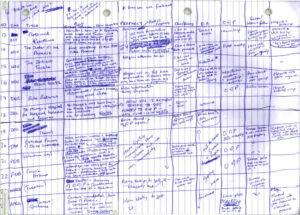
J.K. Rowling’s plot guideline. No doubt it helped!
Moonsick (working title) is my novel for Young Adults, a story based on the teen years of Josephine Bonaparte’s daughter Hortense. Is the novel too giddy? Too dark? I’m frankly not sure. This is why beta readers — teen beta readers — will be important to my final revision process.
Teen beta readers wanted
Later that same day I sent out a newsletter that included a call for teen beta readers. I now have three readers, and (I hope) more to come. I’d also like to find a book club that reads YA fiction — not exclusively, but often enough that they are comfortable with the genre. It occurs to me that a high school English class might be interested in reading it (although it really is a novel for girls). Let me know if you have a teen reader or a book club or class to suggest.
Going back to where it all began
Looking for reader guidelines I’ve used in the past, I discovered a blog post I wrote in February of 2012 — five years ago! — announcing that I would be writing a YA novel about Hortense.
Hortense as a teen — the subject of my next-next novel (Surprise!)
(Note that This Bright Darkness, mentioned in the post, was the working title of The Shadow Queen, which was published two years later, in the spring of 2014.)

Lovely Hortense as a teen. Energetic, creative, talented — a bright spark.
SaveSave
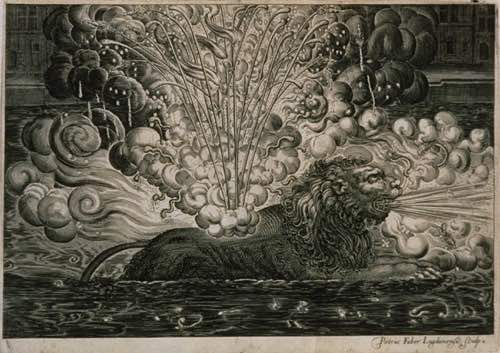
by Sandra Gulland | Jan 5, 2017 | Adventures of a Writing Life |
The image above is Fireworks for the Entry of Louis XIII and Anne of Austria: The Lion, in “Reception de Louis XIII,” Lyons, 1623.
Happy New 2017!
I like the feel of this year already. I’ve weaned myself — to some extent — from toxic international news and immersed myself in finishing the eighth draft of Moonsick, my YA novel about Josephine’s daughter Hortense. (Yikes! Due this month.)
The funny side of revision
This is what revision sometimes feels like … 
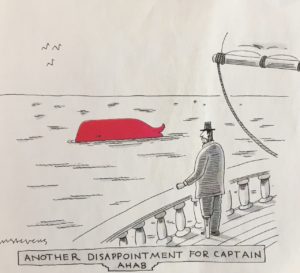
A New Yorker cartoon.
Newsletter coming
I’m also getting ready to send out a newsletter. Sign up here if you haven’t done so already. I will post links to it when it’s ready, but one advantage of signing up is that a subscriber wins one of my books with each newsletter.
A great audible edition of Middlemarch
When I’m not revising, or enjoying one of the many wonderful restaurants here in San Miguel de Allende with my husband, or puzzling over my latest watercolour, I’m listening to an absolutely outstanding audible edition of Middlemarch by George Eliot. This classic novel was destined to be forever on my Novels I’m Embarrassed to Admit I’ve Never Read List — in part because I just couldn’t cope with the pace and prose — but the narration by Juliet Stevenson really makes it come alive. Highly recommended!
Again, Happy New Year! You readers are the absolute best.
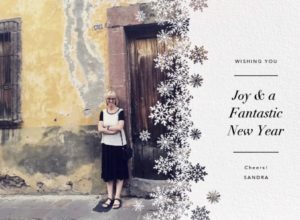
What audible recordings are your favourite? I’m always looking for recommendations.
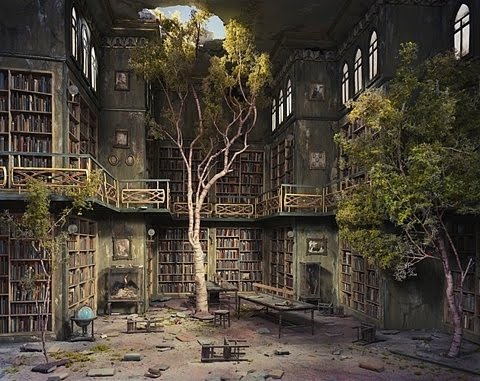
by Sandra Gulland | Dec 26, 2016 | Adventures of a Writing Life, Resources for Readers, Resources for Writers, The Writing Process |
Where have I been?
I’ve been MIA here … why? Partly it had to do with a big change to my website, which threw me off. I couldn’t quite figure out how to navigate it, and various visuals I used before were suddenly missing. I was, as they say “all 6s and 7s” (an expression I love).
Also, I’ve been struggling to finish Moonsick, the working title of the Young Adult historical novel I’ve been writing. For years. The final stages are always the most intense.
Why is it always like this for me? Even now, in the 8th draft, I sometimes feel I’m just scratching the surface of this story.
The return to Real Life
But enough of my whining! It’s Boxing Day, our lovely Christmas holiday is behind us. I’ve played with my new toys, and now it’s time to begin to get back on track. Real Life.
My plan, now, is to go through the manuscript, copy out all the scenes that pertain to Napoleon and paste them into another file. Napoleon’s relationship with his stepdaughter Hortense is key to this novel, and I need to make sure that there is a clear arc. It’s a time-consuming approach, but I used it analyzing the arc of Hortense’s relationship with her music teacher (another important thread), and I was glad I did.
And so, onto Napoleon …
From the good book department
I recently read, and loved:
Commonwealth, by Ann Patchett
Tell Me Three Things, by Julie Buxbaum
The Girls, by Emma Cline
Each of these novels kept me up reading too late into the night. Highly recommended.
Who knows? I might even post again before the New Year, but if I don’t, have a Happy New Year!

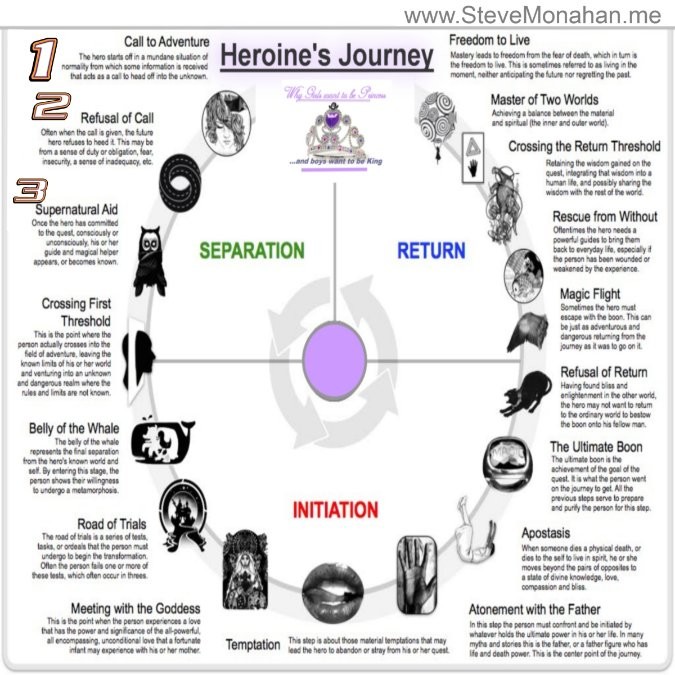
by Sandra Gulland | Apr 12, 2016 | Adventures of a Writing Life, On Plot |
I’ve been addicted to the theory of the Hero’s Journey as story structure since I read Cambell’s groundbreaking work,The Hero With a Thousand Faces, in high school. It’s at the core of virtually every book I admire on plot: The Writer’s Journey by Christopher Vogler, Save the Cat by Blake Snyder, Story by Robert McKee, The Anatomy of Story by John Truby, to name a few.
Yet, increasingly, I’ve been bothered by the feeling that there’s something missing, something that doesn’t quite fit the structure of a Heroine’s journey.
The Heroine’s Journey
There have been many alternative structures proposed (see here, and here, for example), but they didn’t really grab me.
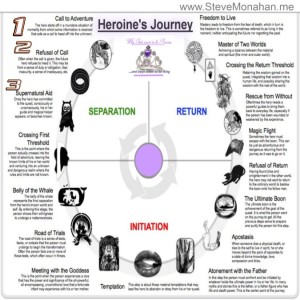
The proposed structures felt a little forced to me. The strength of Cambell’s work is that it arose out an examination of popular stories. He began with what worked, and then looked for why. I didn’t feel that those proposing a structure for a Heroine’s Journey were evolving theories by examining actual stories.
Birth vs. Battle, a recent blog essay on Writer Unboxed by David Corbett, offers a solution. He begins by positing: “Conflict is not the engine of story.”
Right away, he has my attention. How many times have I wondered why every Hero’s Journey seems to involve a battle (what Corbett points out Ursula Le Guin called the “gladiatorial view of fiction”).
Corbett goes on to demonstrate that it isn’t conflict that creates movement, but desire.
“Conflict is desire meeting resistance.”
The three basic plot lines
Corbett states that there are “typically three plot lines in any meaningful story.” To summarize:
- The desire line… (outer pursuit)
- The yearning line… (inner pursuit)
- The connection line… (the relationships that help or hinder)
He points out that, “The most compelling stories unify these plot lines.”
(I’ve abbreviated greatly. Be sure to read his post in full.)
So far we’re on fairly familiar terrain, but Corbett differs in that he emphasizes the importance of the connection line.
The importance of connection
The traditional Hero, typically, is something of a loner. He acquires helpers and overcomes enemies, but emerges the sole victor. This model doesn’t really work for the Heroine, somehow. At least not for my heroines, much less for the heroines of the novels that truly move me.
Gin up as much conflict as you want, without desire to generate movement, yearning to create meaning, and other people to provide emotional richness and texture, all you have is sound and fury, and we all know how that phrase ends.
I was a Young Adult book editor in my 30s, editing a series of novels aimed at teen reluctant readers. It wasn’t PC — even more so at that time — but I came to the private conclusion that, in general, boys were drawn to stories that made their muscles twitch (conflict), while girls, frankly, liked to cry (connection).
This is a gross generalization, of course, and there are plenty of exceptions, but I do think it speaks to my own basic issue with the traditional conflict-based story structure.
We may be born alone and die alone but we grow through our engagement with the world—specifically, other people.
This is so refreshing. I’ve ordered THE ART OF CHARACTER; Creating Memorable Characters, for Fiction, Film and TV, Corbett’s book on writing. I look forward to learning more from him.
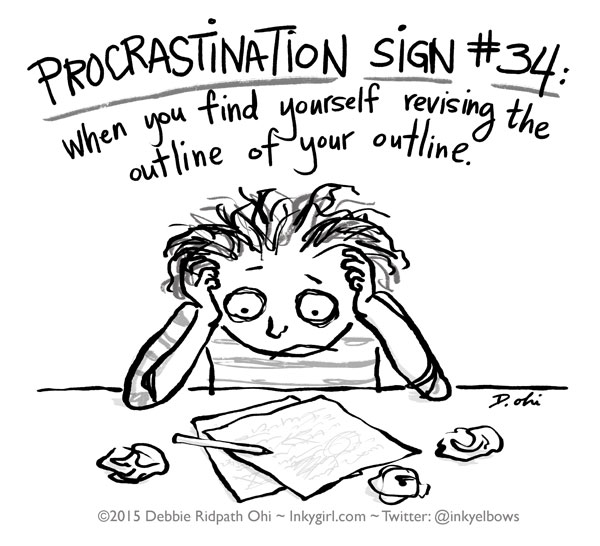
by Sandra Gulland | Mar 20, 2016 | Adventures of a Writing Life |
I haven’t posted here for some time. It’s not that I don’t have a lot to share — I do! — but, rather, whenever I think to post to my blog I realize that I really should be writing … or revising … or researching …
You get the picture.
For all of the above reasons, this wonderful cartoon on procrastination by Debbie Ridpath Ohi really resonated with me:
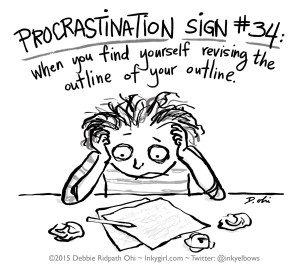
Perfect, don’t you think?
More anon … although not likely until the end of April. I’m on a tight deadline to reign in this MS. It’s not due until July 1, but May is going to be taken up with moving-back-to-Canada turmoil, and as for June … our daughter is having a baby! So, given all that, I want to have most of the challenging parts of Draft 6 blocked out before we head north, with only the little fiddly parts left to smooth out.
I hope you have a wonderful spring!
(Back to revising the outline my outline. ;-)













